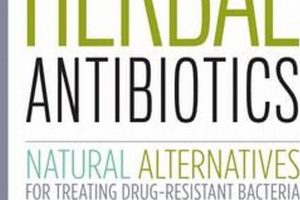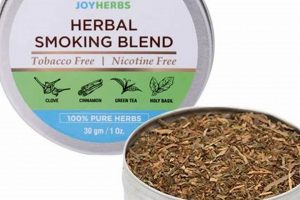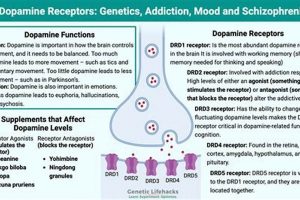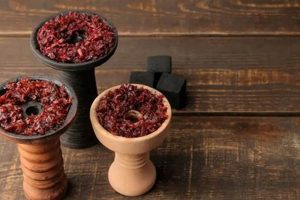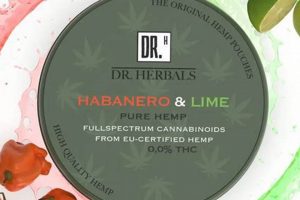The action of providing or distributing herbal remedies, often following a consultation or prescription, is a critical step in ensuring appropriate and safe usage. This activity, usually carried out by trained herbalists, pharmacists, or healthcare professionals, ensures that patients receive the correct herbs, in the correct form, and at the correct dosage. For instance, a qualified practitioner might recommend and then oversee the provision of chamomile tea for its calming effects, guiding the user on preparation and consumption.
The significance of accurate provision lies in maximizing therapeutic benefits while minimizing potential risks associated with herbal treatments. Historically, the careful distribution of plant-based medicines has been a cornerstone of traditional healing systems across various cultures. This process ensures quality control, avoids misidentification of plants, and accounts for individual patient factors like allergies, drug interactions, and pre-existing conditions, ultimately promoting positive health outcomes.
This article will further examine the regulatory landscape surrounding the provisioning of plant-based medicines, detail the educational requirements for practitioners involved, and analyze current trends in this growing field. The focus will then shift to best practices, quality assurance, and the evolving role of technology in the field.
Guidance for Effective Provisioning of Herbal Products
The following guidelines offer practical advice for practitioners involved in the dispensing of herbal remedies, aimed at optimizing therapeutic outcomes and ensuring patient safety.
Tip 1: Accurate Identification is Paramount. Verify the botanical identity of all herbal ingredients through reputable sources and, when possible, macroscopic and microscopic examination. Misidentification can lead to ineffective treatment or adverse reactions.
Tip 2: Prioritize Quality Sourcing. Obtain herbs from suppliers who adhere to Good Agricultural and Collection Practices (GACP) and can provide certificates of analysis confirming purity, potency, and the absence of contaminants such as heavy metals, pesticides, and adulterants.
Tip 3: Implement Standardized Dispensing Protocols. Establish clear procedures for measuring, packaging, and labeling herbal preparations to ensure consistency and reduce the risk of errors. Use calibrated equipment and maintain accurate records.
Tip 4: Provide Comprehensive Patient Counseling. Educate patients on the proper use, dosage, and potential side effects of the herbal remedies they receive. Address any concerns and contraindications, emphasizing the importance of adherence to the recommended regimen.
Tip 5: Maintain Detailed Records. Keep thorough records of all products dispensed, including batch numbers, expiration dates, and patient information. This enables traceability and facilitates effective management of adverse events, should they occur.
Tip 6: Monitor for Adverse Reactions. Establish a system for patients to report any adverse reactions experienced after using the dispensed herbs. Promptly investigate and document all reports to identify potential problems and inform future practices.
Tip 7: Stay Informed on Herb-Drug Interactions. Maintain an awareness of potential interactions between herbal remedies and pharmaceutical medications. Consult reputable databases and resources to identify potential risks and adjust treatments accordingly.
These best practices underscore the importance of precision, diligence, and patient-centered care in the provisioning of herbal medicine. Adhering to these recommendations will help maximize therapeutic efficacy and promote the safe and responsible integration of herbal therapies into overall healthcare.
The subsequent sections will delve into the legal frameworks governing the supplying of plant-derived products, emphasizing the need for ongoing professional development and commitment to evidence-based practice.
1. Accurate Identification
The process of herbal dispense is inextricably linked to accurate botanical identification. Erroneous identification represents a foundational failure, negating any potential therapeutic benefit and introducing substantial risks. The act of providing herbal remedies inherently requires certainty regarding the plant species and part being dispensed. Consider the consequences of misidentifying foxglove (Digitalis purpurea) as comfrey (Symphytum officinale). The former contains potent cardiac glycosides, while the latter, historically used for wound healing, contains pyrrolizidine alkaloids. Dispensing foxglove under the guise of comfrey could induce severe cardiotoxicity, necessitating emergency medical intervention. This scenario underscores that identification is not merely a preliminary step but a critical safety imperative.
The importance of accurate identification extends beyond preventing acute toxicity. Chronic exposure to misidentified herbs, even in small quantities, can lead to insidious health problems. For example, the adulteration of herbal products with aristolochic acids, often stemming from misidentification or substitution, has been linked to nephrotoxicity and urothelial cancer. The ramifications are not limited to direct physiological harm; erroneous identification erodes patient trust and undermines the credibility of herbal medicine as a whole. Rigorous quality control measures, including macroscopic and microscopic examination, chemical analysis, and DNA barcoding, are thus essential components of responsible herbal dispense.
In conclusion, accurate identification stands as the bedrock of safe and effective herbal dispense. The potential for adverse events arising from misidentification necessitates stringent protocols and a commitment to ongoing education and training for practitioners. Failing to prioritize this fundamental aspect jeopardizes patient well-being and undermines the integrity of the entire field. Addressing this challenge requires a multi-faceted approach encompassing rigorous quality control, expert knowledge, and a steadfast adherence to ethical practices.
2. Quality Sourcing
The process of herbal dispense is inextricably linked to the quality of source material. The efficacy and safety of any herbal preparation are directly determined by the origin, cultivation, and handling of the plants from which it is derived. Poorly sourced herbs may contain contaminants, lack the necessary bioactive compounds, or be incorrectly identified, rendering the final product ineffective or even harmful. The act of responsible herbal dispense, therefore, necessitates a meticulous approach to sourcing, prioritizing suppliers who adhere to stringent quality control measures.
Consider the example of echinacea, widely used for immune support. Echinacea cultivated in contaminated soil can accumulate heavy metals, negating its potential benefits and introducing a toxic burden to the patient. Similarly, herbs harvested from areas with high pesticide usage may contain harmful residues, posing a health risk. Furthermore, improperly dried or stored herbs can be susceptible to mold and microbial growth, further compromising their quality and safety. Therefore, suppliers must provide verifiable certificates of analysis demonstrating the purity, potency, and absence of contaminants in their herbal products.
In conclusion, quality sourcing is not merely a desirable attribute of herbal dispense but a fundamental requirement for ensuring patient safety and therapeutic efficacy. Responsible practitioners must prioritize suppliers who can demonstrate a commitment to sustainable harvesting practices, rigorous quality control measures, and accurate botanical identification. By understanding the direct correlation between quality sourcing and the final product, practitioners can make informed decisions that promote the responsible and effective use of herbal medicine.
3. Dosage Precision
Dosage precision is paramount in the field of herbal dispense, directly impacting therapeutic efficacy and patient safety. Unlike synthetic pharmaceuticals, herbal remedies often possess a complex composition of active compounds, necessitating careful consideration of dosage to achieve desired outcomes and minimize potential adverse effects.
- Individual Variability in Response
Patient physiology, age, weight, metabolism, and pre-existing conditions significantly influence how the body processes and responds to herbal constituents. A standardized dose may be ineffective for some individuals while causing adverse reactions in others. For example, a liver condition may impair the metabolism of certain herbal compounds, leading to elevated blood levels and increased risk of toxicity. Accurate evaluation of patient-specific factors is critical for determining appropriate dosage adjustments.
- Standardization Challenges
Herbal preparations can vary considerably in potency due to factors such as growing conditions, harvesting methods, and processing techniques. This variability presents a challenge for dosage precision. While standardization of extracts based on marker compounds offers some degree of consistency, it does not always guarantee predictable therapeutic effects due to the potential synergy of various constituents. Therefore, practitioners must exercise caution and monitor patient responses closely, even when using standardized products.
- Formulation and Delivery Methods
The chosen formulation and method of delivery can substantially influence the bioavailability and absorption rate of herbal compounds. Tinctures, capsules, teas, and topical applications exhibit different pharmacokinetic profiles, requiring dosage adjustments to achieve desired blood concentrations. For instance, a standardized dose of an herb delivered via a tincture might result in faster absorption and a higher peak concentration compared to the same dose administered in a capsule. Practitioners must select the appropriate formulation and delivery method based on the specific herb and the patient’s needs.
- Potential for Interactions
Herbal remedies can interact with pharmaceutical medications, altering their metabolism or pharmacodynamic effects. These interactions can significantly impact dosage requirements, potentially leading to subtherapeutic outcomes or increased toxicity. For example, St. John’s Wort can induce cytochrome P450 enzymes, increasing the metabolism of several pharmaceuticals and reducing their effectiveness. Thorough medication reconciliation and careful consideration of potential interactions are crucial for ensuring dosage precision.
In summation, dosage precision in herbal dispense is a multifaceted challenge demanding a nuanced approach. Success requires a comprehensive understanding of individual patient factors, herbal composition, formulation considerations, and potential interactions. Ongoing education, meticulous record-keeping, and continuous monitoring of patient responses are essential for optimizing therapeutic outcomes and minimizing risks associated with herbal medicine.
4. Patient Education
Patient education constitutes an indispensable component of responsible herbal dispense. The act of providing herbal remedies extends beyond simply handing over a product; it necessitates a comprehensive understanding by the patient regarding the intended use, potential risks, and expected outcomes. A lack of adequate patient education can negate the therapeutic benefits of an herb and, more seriously, lead to adverse events arising from misuse, incorrect dosage, or interactions with existing medications. For example, a patient receiving an herbal sleep aid without proper instruction might combine it with alcohol, thereby potentiating sedative effects to a dangerous degree. The effectiveness of the dispense hinges not only on the correct selection and preparation of the remedy but also on the patient’s capacity to use it safely and appropriately.
Effective patient education entails several key elements. Clear and concise communication of the herb’s intended purpose and mechanism of action empowers patients to understand the rationale behind its use. Detailed instructions regarding dosage, timing, and method of administration are crucial for ensuring optimal therapeutic effects. Comprehensive discussion of potential side effects, contraindications, and interactions with other medications or supplements allows patients to make informed decisions and monitor for adverse reactions. This necessitates a proactive approach from the dispensing practitioner, utilizing multiple channels of communication, such as verbal instruction, written materials, and follow-up consultations, to reinforce key information. Furthermore, addressing patient concerns and answering questions honestly and transparently fosters trust and encourages adherence to the prescribed regimen.
In conclusion, patient education is not merely an adjunct to herbal dispense but an intrinsic element of the process. Prioritizing clear, comprehensive, and patient-centered education enhances treatment outcomes, minimizes potential risks, and empowers individuals to actively participate in their own healthcare. The challenges of conveying complex information in an accessible manner require ongoing refinement of communication strategies and a commitment to fostering patient understanding. This commitment underscores the ethical responsibility inherent in the provision of herbal medicine and promotes the safe and effective integration of herbal therapies into overall healthcare practices.
5. Interaction Awareness
The practice of herbal dispense demands a high level of interaction awareness, specifically pertaining to the potential for herb-drug, herb-herb, and herb-disease interactions. This awareness functions as a critical safety net, preventing adverse events and optimizing therapeutic outcomes in patients receiving herbal remedies. The consequences of neglecting interaction awareness can range from reduced drug efficacy to life-threatening complications.
- Herb-Drug Interactions: Pharmacokinetic Effects
This facet addresses how herbal remedies can alter the absorption, distribution, metabolism, or excretion of pharmaceutical drugs. For example, St. John’s Wort (Hypericum perforatum) is a well-known inducer of cytochrome P450 enzymes, leading to reduced plasma concentrations of drugs like warfarin, oral contraceptives, and certain antidepressants. Conversely, grapefruit juice can inhibit cytochrome P450 enzymes, potentially increasing drug levels and the risk of toxicity. Understanding these pharmacokinetic interactions is crucial for avoiding therapeutic failure or adverse drug reactions.
- Herb-Drug Interactions: Pharmacodynamic Effects
Pharmacodynamic interactions occur when herbs and drugs have additive, synergistic, or antagonistic effects at the same receptor or target site. For instance, combining valerian (Valeriana officinalis), known for its sedative properties, with benzodiazepines can potentiate central nervous system depression, leading to excessive drowsiness and impaired coordination. Conversely, an herb with diuretic properties could antagonize the effects of an antihypertensive medication, rendering it less effective. Awareness of these combined pharmacological actions is vital for preventing unwanted or dangerous effects.
- Herb-Herb Interactions
Just as drugs can interact with each other, so too can different herbal remedies. This aspect is often overlooked, yet it’s equally important. The combined use of multiple herbs, each possessing potent bioactivity, can lead to unpredictable and potentially harmful consequences. For example, combining herbs with anticoagulant properties, such as garlic, ginger, and ginkgo, may increase the risk of bleeding, particularly in patients already taking anticoagulant medications or undergoing surgery. Careful consideration of the combined effects of multiple herbs is essential for ensuring patient safety.
- Herb-Disease Interactions
Certain herbs may be contraindicated in individuals with specific medical conditions. This is due to the herb exacerbating the disease state or interfering with conventional medical treatments. For example, the use of immune-stimulating herbs like echinacea in individuals with autoimmune disorders, such as lupus or rheumatoid arthritis, requires caution due to the potential to exacerbate autoimmune activity. Understanding these interactions is vital for preventing harm to vulnerable patients.
In conclusion, interaction awareness is not a passive understanding, but an active and continuous process during herbal dispense. It requires consistent monitoring of the current scientific literature, comprehensive patient history taking, and a collaborative approach with other healthcare providers. The complexities of these interactions necessitate a high degree of professional responsibility and a commitment to evidence-based practice in the provision of herbal medicine, especially in those patients with complex medical histories or who are taking multiple medications.
6. Regulatory Compliance
Regulatory compliance constitutes a non-negotiable element within the practice of herbal dispense. The absence of adherence to relevant regulations exposes practitioners and patients to significant risks, including legal repercussions, compromised product quality, and potential health hazards. Regulations governing herbal products vary significantly across jurisdictions, encompassing aspects such as licensing requirements for practitioners, quality control standards for manufacturing and sourcing, labeling specifications, and restrictions on the sale of certain herbs. Failure to comply with these regulations can lead to fines, legal action, and the revocation of licenses, undermining the legitimacy and sustainability of the practice. Consider, for example, the regulatory framework surrounding herbal products in Germany, where specific herbs are classified as medicinal products and subject to stringent approval processes comparable to pharmaceuticals. Practitioners dispensing these herbs without proper authorization would face severe penalties. This illustrates how regulatory compliance shapes and constrains the parameters of legal and ethical herbal dispense. It is therefore a core component, integral to any legitimate practice.
The benefits of regulatory compliance extend beyond mere adherence to legal requirements. Compliance fosters a culture of quality assurance, traceability, and transparency within the herbal medicine industry. Regulations concerning Good Manufacturing Practices (GMP) mandate that herbal products are manufactured in a controlled environment, with rigorous testing to ensure purity, potency, and freedom from contaminants. Labeling regulations require accurate disclosure of ingredients, potential allergens, and recommended dosage, empowering consumers to make informed decisions. Traceability systems, often mandated by regulations, enable the identification and recall of substandard or adulterated products, protecting public health. For instance, the implementation of stringent GMP standards for herbal manufacturers in the United States has led to improved product quality and reduced incidents of adulteration, strengthening consumer confidence and promoting the responsible growth of the herbal medicine sector. These examples highlight how the effects of strict adherence to the regulatory compliance has positive impacts on the sector.
In conclusion, regulatory compliance is inextricably linked to the responsible and ethical practice of herbal dispense. Adherence to relevant regulations protects both practitioners and patients, promotes product quality and safety, and fosters trust within the herbal medicine industry. The complexities of navigating diverse regulatory landscapes necessitate ongoing professional development and a commitment to upholding the highest standards of ethical conduct. The challenges lie in harmonizing regulatory frameworks across jurisdictions and ensuring that regulations are evidence-based and proportionate to the risks associated with herbal products. This multifaceted approach ensures the continued viability and responsible integration of herbal medicine into the broader healthcare landscape.
Frequently Asked Questions
The following section addresses common inquiries and clarifies misconceptions regarding the sourcing, preparation, and utilization of herbal remedies.
Question 1: What qualifications are necessary to engage in herbal dispense professionally?
The required qualifications vary depending on the jurisdiction. Generally, formal training in herbal medicine, pharmacology, or a related field is essential. Licensing or certification may also be mandated to ensure competency and adherence to safety standards. Consultation with local regulatory bodies is advised.
Question 2: How can one verify the authenticity and purity of an herbal product?
Request a Certificate of Analysis (COA) from the supplier. This document should detail the results of tests conducted to identify the plant species, assess its potency, and detect the presence of contaminants such as heavy metals, pesticides, and microbial pathogens. Independent laboratory verification is also recommended.
Question 3: What are the primary considerations when determining the appropriate dosage of an herbal remedy?
Dosage determination should account for individual factors such as age, weight, health status, and concurrent medications. The potency of the herbal preparation, the specific plant part used, and the method of administration also influence the dosage regimen. Consultation with a qualified herbal practitioner is advised for personalized dosage recommendations.
Question 4: Are there specific herbal remedies that should never be combined with conventional medications?
Numerous herbs possess the potential to interact with conventional medications, either by altering their metabolism or by potentiating or antagonizing their effects. Examples include St. John’s Wort (Hypericum perforatum), which can interact with certain antidepressants and oral contraceptives, and warfarin, which can interact with anticoagulant herbs like garlic and ginger. A comprehensive medication review is essential prior to initiating any herbal therapy.
Question 5: What steps should be taken if an adverse reaction is suspected following the ingestion or application of an herbal product?
Discontinue use of the product immediately. Seek medical attention if symptoms are severe or persistent. Report the adverse reaction to the dispensing practitioner and the relevant regulatory authorities. Preserve the remaining product for analysis, as it may provide valuable clues regarding the cause of the reaction.
Question 6: How does one stay informed about the latest research and safety information regarding herbal medicine?
Engage in continuing education activities, such as attending conferences and workshops. Consult reputable scientific databases and professional journals specializing in herbal medicine. Seek mentorship from experienced practitioners and participate in collaborative learning networks. Regularly review updates from regulatory agencies regarding safety alerts and product recalls.
These answers provide a foundational understanding of key considerations in herbal dispense. However, the complexities of herbal medicine require ongoing education and diligent attention to safety protocols.
The following section will delve into future trends and innovations in the practice.
Conclusion
This article has explored various facets of herbal dispense, emphasizing the necessity of accurate identification, quality sourcing, precise dosage, comprehensive patient education, thorough interaction awareness, and strict regulatory compliance. These elements collectively define the parameters of responsible and ethical practice within this field. The potential benefits of plant-based remedies are inextricably linked to the diligence and expertise applied during the provisioning process. Failure to uphold these standards compromises patient safety and undermines the credibility of herbal medicine as a viable therapeutic option.
The ongoing evolution of herbal medicine demands a continued commitment to rigorous scientific inquiry, evidence-based practice, and unwavering ethical conduct. Healthcare professionals and practitioners engaged in dispensing should remain vigilant, seeking to refine their knowledge and skills through continuous professional development. Further research into the efficacy and safety of herbal remedies, coupled with robust regulatory oversight, is essential for ensuring the responsible and effective integration of herbal medicine into contemporary healthcare systems.


